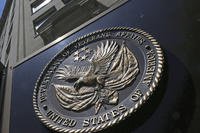A Nepalese army column found the wreckage of a Marine UH-1Y Huey helicopter that went missing and crashed on May 12 at about 11,000 feet in the Himalayas, killing the six Marines and two Nepalese soldiers aboard.
"It was a very severe crash and based on what we saw and the condition of the aircraft; we believe there were no survivors," Marine Lt. Gen. John Wissler told a press briefing in Kathmandu, the capital.
Nepal's defense secretary, Ishwori Paudyal, said that three charred bodies had been found at the scene and it was unlikely that there were any survivors.
The military received no distress calls from the Huey before it went missing Tuesday but Wissler pledged that "We will determine the cause" of the accident that occurred as Nepal was experiencing its second major earthquake in just over two weeks.
"The assessment of the site is ongoing and a thorough investigation will be conducted," the U.S. Pacific Command said in a statement.
The accident occurred at an elevation of 11,000 feet eight miles north of Charikot, a village about 80 miles east of Kathmandu.
The Huey from Marine Light Attack Helicopter squadron 469 based at Camp Pendleton, Calif., had been delivering rice and tarps in Charikot, the area worst hit by Tuesday's quake. The helicopter had dropped off supplies at one site and was enroute to a second when contact was lost.
An Indian Army helicopter flying in the same area Tuesday reported hearing a transmission from the Huey about a fuel problem aboard, but U.S. military officials in Nepal and at the Pentagon said they have been unable thus far to confirm the Indian helicopter's report.
On Thursday, Marine Brig. Gen. Paul Kennedy, deputy commander of the 3rd Marine Expeditionary Force, said that the Huey had been nearing the end of its relief mission on Tuesday when it went missing.
"The terrain out there is the roughest in the world," Kennedy said, and the area also had experienced numerous landslides in the earthquakes.
For two days, two Marine Hueys and two Marine MV-22 Osprey tilt-rotor aircraft had searched from the air while about 400 Nepalese troops worked the ground without results before Nepalese soldiers found the crash site Friday.
The helicopter had GPS and an emergency transponder but the air search had failed to pick up any signals. Pentagon officials speculated that the Huey may have gone down in a "dead zone" for signals in the rugged terrain.
Wissler, commander of the 3rd Marine Expeditionary Force and head of Joint Task Force 505 in Nepal, said the wreckage was in "extremely dense forest and exceptionally rugged terrain." He said he called off the search for remains at nightfall because of conditions of below freezing weather coupled with "extremely violent thunderstorms."
Nepalese officials said three sets of remains were initially found while U.S. officials said two sets of remains had been visually identified.
At the Pentagon, Army Col. Steve Warren, a spokesman, said that the families of the Marines had been told that their loved ones were aboard the Huey but none of the Marines as yet had been officially declared dead. However, Warren added that "It is likely that they all perished."
Wissler praised the six Marines and two Nepalese aboard the helicopter who were "determined to come to the rescue of those in need. They were courageous."
Despite the loss, "the U.S. military will remain committed to the mission in Nepal. We will continue to stand with Nepal for as long as our friends need our help."
President Obama mourned the loss of the Marines and said they represented "a truth that guides our work around the world: When our friends are in need, America helps."
Defense Secretary Ashton Carter said that "this tragedy is a reminder of the vital but dangerous role American service members play in delivering humanitarian assistance and disaster relief."
The U.S. relief mission, in which the military was supporting the State Departments Agency for International Development, was deployed shortly after a magnitude-7.8 quake hit Nepal on April 25, killing more than 8,200 people. The first quake was followed a second 7.3-maginitude quake on Tuesday that killed 117 people and injured 2,800.
-- Richard Sisk can be reached at richard.sisk@military.com





























